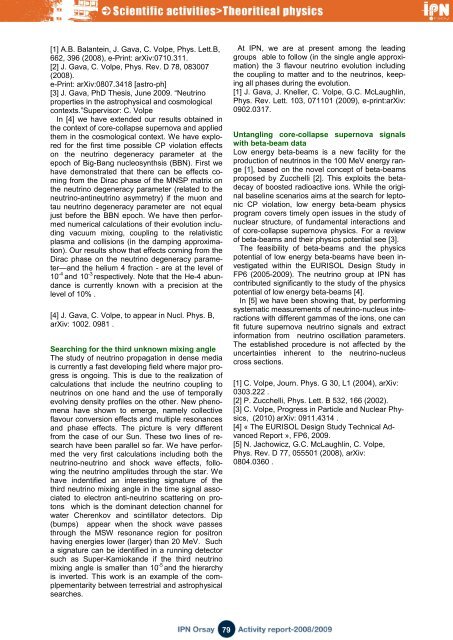exotic nuclei structure and reaction noyaux exotiques ... - IPN - IN2P3
exotic nuclei structure and reaction noyaux exotiques ... - IPN - IN2P3
exotic nuclei structure and reaction noyaux exotiques ... - IPN - IN2P3
You also want an ePaper? Increase the reach of your titles
YUMPU automatically turns print PDFs into web optimized ePapers that Google loves.
[1] A.B. Balantein, J. Gava, C. Volpe, Phys. Lett.B,<br />
662, 396 (2008), e-Print: arXiv:0710.311.<br />
[2] J. Gava, C. Volpe, Phys. Rev. D 78, 083007<br />
(2008).<br />
e-Print: arXiv:0807.3418 [astro-ph]<br />
[3] J. Gava, PhD Thesis, June 2009. “Neutrino<br />
properties in the astrophysical <strong>and</strong> cosmological<br />
contexts.”Supervisor: C. Volpe<br />
In [4] we have extended our results obtained in<br />
the context of core-collapse supernova <strong>and</strong> applied<br />
them in the cosmological context. We have explored<br />
for the first time possible CP violation effects<br />
on the neutrino degeneracy parameter at the<br />
epoch of Big-Bang nucleosynthsis (BBN). First we<br />
have demonstrated that there can be effects coming<br />
from the Dirac phase of the MNSP matrix on<br />
the neutrino degeneracy parameter (related to the<br />
neutrino-antineutrino asymmetry) if the muon <strong>and</strong><br />
tau neutrino degeneracy parameter are not equal<br />
just before the BBN epoch. We have then performed<br />
numerical calculations of their evolution including<br />
vacuum mixing, coupling to the relativistic<br />
plasma <strong>and</strong> collisions (in the damping approximation).<br />
Our results show that effects coming from the<br />
Dirac phase on the neutrino degeneracy parameter—<strong>and</strong><br />
the helium 4 fraction - are at the level of<br />
10 -4 <strong>and</strong> 10 -3 respectively. Note that the He-4 abundance<br />
is currently known with a precision at the<br />
level of 10% .<br />
[4] J. Gava, C. Volpe, to appear in Nucl. Phys. B,<br />
arXiv: 1002. 0981 .<br />
Searching for the third unknown mixing angle<br />
The study of neutrino propagation in dense media<br />
is currently a fast developing field where major progress<br />
is ongoing. This is due to the realization of<br />
calculations that include the neutrino coupling to<br />
neutrinos on one h<strong>and</strong> <strong>and</strong> the use of temporally<br />
evolving density profiles on the other. New phenomena<br />
have shown to emerge, namely collective<br />
flavour conversion effects <strong>and</strong> multiple resonances<br />
<strong>and</strong> phase effects. The picture is very different<br />
from the case of our Sun. These two lines of research<br />
have been parallel so far. We have performed<br />
the very first calculations including both the<br />
neutrino-neutrino <strong>and</strong> shock wave effects, following<br />
the neutrino amplitudes through the star. We<br />
have indentified an interesting signature of the<br />
third neutrino mixing angle in the time signal associated<br />
to electron anti-neutrino scattering on protons<br />
which is the dominant detection channel for<br />
water Cherenkov <strong>and</strong> scintillator detectors. Dip<br />
(bumps) appear when the shock wave passes<br />
through the MSW resonance region for positron<br />
having energies lower (larger) than 20 MeV. Such<br />
a signature can be identified in a running detector<br />
such as Super-Kamiok<strong>and</strong>e if the third neutrino<br />
mixing angle is smaller than 10 -5 <strong>and</strong> the hierarchy<br />
is inverted. This work is an example of the complpementarity<br />
between terrestrial <strong>and</strong> astrophysical<br />
searches.<br />
At <strong>IPN</strong>, we are at present among the leading<br />
groups able to follow (in the single angle approximation)<br />
the 3 flavour neutrino evolution including<br />
the coupling to matter <strong>and</strong> to the neutrinos, keeping<br />
all phases during the evolution.<br />
[1] J. Gava, J. Kneller, C. Volpe, G.C. McLaughlin,<br />
Phys. Rev. Lett. 103, 071101 (2009), e-print:arXiv:<br />
0902.0317.<br />
Untangling core-collapse supernova signals<br />
with beta-beam data<br />
Low energy beta-beams is a new facility for the<br />
production of neutrinos in the 100 MeV energy range<br />
[1], based on the novel concept of beta-beams<br />
proposed by Zucchelli [2]. This exploits the betadecay<br />
of boosted radioactive ions. While the original<br />
baseline scenarios aims at the search for leptonic<br />
CP violation, low energy beta-beam physics<br />
program covers timely open issues in the study of<br />
nuclear <strong>structure</strong>, of fundamental interactions <strong>and</strong><br />
of core-collapse supernova physics. For a review<br />
of beta-beams <strong>and</strong> their physics potential see [3].<br />
The feasibility of beta-beams <strong>and</strong> the physics<br />
potential of low energy beta-beams have been investigated<br />
within the EURISOL Design Study in<br />
FP6 (2005-2009). The neutrino group at <strong>IPN</strong> has<br />
contributed significantly to the study of the physics<br />
potential of low energy beta-beams [4].<br />
In [5] we have been showing that, by performing<br />
systematic measurements of neutrino-nucleus interactions<br />
with different gammas of the ions, one can<br />
fit future supernova neutrino signals <strong>and</strong> extract<br />
information from neutrino oscillation parameters.<br />
The established procedure is not affected by the<br />
uncertainties inherent to the neutrino-nucleus<br />
cross sections.<br />
[1] C. Volpe, Journ. Phys. G 30, L1 (2004), arXiv:<br />
0303.222 .<br />
[2] P. Zucchelli, Phys. Lett. B 532, 166 (2002).<br />
[3] C. Volpe, Progress in Particle <strong>and</strong> Nuclear Physics,<br />
(2010) arXiv: 0911.4314 .<br />
[4] « The EURISOL Design Study Technical Advanced<br />
Report », FP6, 2009.<br />
[5] N. Jachowicz, G.C. McLaughlin, C. Volpe,<br />
Phys. Rev. D 77, 055501 (2008), arXiv:<br />
0804.0360 .<br />
79

















